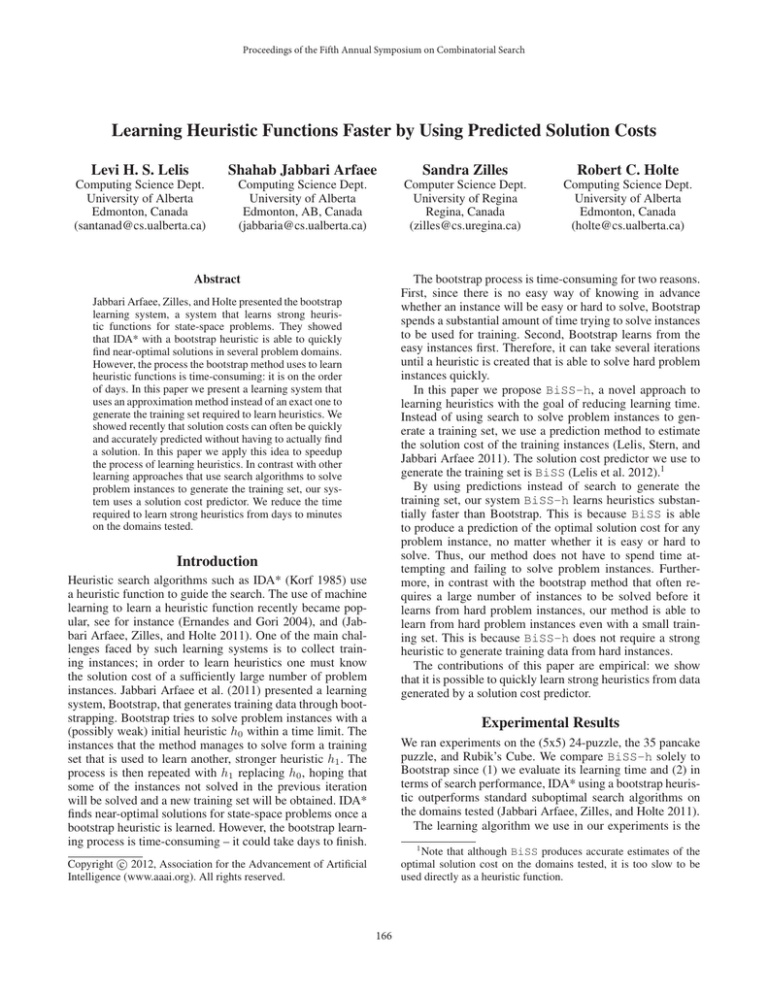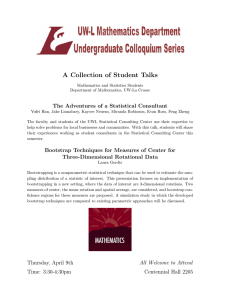
Proceedings of the Fifth Annual Symposium on Combinatorial Search
Learning Heuristic Functions Faster by Using Predicted Solution Costs
Levi H. S. Lelis
Shahab Jabbari Arfaee
Sandra Zilles
Robert C. Holte
Computing Science Dept.
University of Alberta
Edmonton, Canada
(santanad@cs.ualberta.ca)
Computing Science Dept.
University of Alberta
Edmonton, AB, Canada
(jabbaria@cs.ualberta.ca)
Computer Science Dept.
University of Regina
Regina, Canada
(zilles@cs.uregina.ca)
Computing Science Dept.
University of Alberta
Edmonton, Canada
(holte@cs.ualberta.ca)
Abstract
The bootstrap process is time-consuming for two reasons.
First, since there is no easy way of knowing in advance
whether an instance will be easy or hard to solve, Bootstrap
spends a substantial amount of time trying to solve instances
to be used for training. Second, Bootstrap learns from the
easy instances first. Therefore, it can take several iterations
until a heuristic is created that is able to solve hard problem
instances quickly.
In this paper we propose BiSS-h, a novel approach to
learning heuristics with the goal of reducing learning time.
Instead of using search to solve problem instances to generate a training set, we use a prediction method to estimate
the solution cost of the training instances (Lelis, Stern, and
Jabbari Arfaee 2011). The solution cost predictor we use to
generate the training set is BiSS (Lelis et al. 2012).1
By using predictions instead of search to generate the
training set, our system BiSS-h learns heuristics substantially faster than Bootstrap. This is because BiSS is able
to produce a prediction of the optimal solution cost for any
problem instance, no matter whether it is easy or hard to
solve. Thus, our method does not have to spend time attempting and failing to solve problem instances. Furthermore, in contrast with the bootstrap method that often requires a large number of instances to be solved before it
learns from hard problem instances, our method is able to
learn from hard problem instances even with a small training set. This is because BiSS-h does not require a strong
heuristic to generate training data from hard instances.
The contributions of this paper are empirical: we show
that it is possible to quickly learn strong heuristics from data
generated by a solution cost predictor.
Jabbari Arfaee, Zilles, and Holte presented the bootstrap
learning system, a system that learns strong heuristic functions for state-space problems. They showed
that IDA* with a bootstrap heuristic is able to quickly
find near-optimal solutions in several problem domains.
However, the process the bootstrap method uses to learn
heuristic functions is time-consuming: it is on the order
of days. In this paper we present a learning system that
uses an approximation method instead of an exact one to
generate the training set required to learn heuristics. We
showed recently that solution costs can often be quickly
and accurately predicted without having to actually find
a solution. In this paper we apply this idea to speedup
the process of learning heuristics. In contrast with other
learning approaches that use search algorithms to solve
problem instances to generate the training set, our system uses a solution cost predictor. We reduce the time
required to learn strong heuristics from days to minutes
on the domains tested.
Introduction
Heuristic search algorithms such as IDA* (Korf 1985) use
a heuristic function to guide the search. The use of machine
learning to learn a heuristic function recently became popular, see for instance (Ernandes and Gori 2004), and (Jabbari Arfaee, Zilles, and Holte 2011). One of the main challenges faced by such learning systems is to collect training instances; in order to learn heuristics one must know
the solution cost of a sufficiently large number of problem
instances. Jabbari Arfaee et al. (2011) presented a learning
system, Bootstrap, that generates training data through bootstrapping. Bootstrap tries to solve problem instances with a
(possibly weak) initial heuristic h0 within a time limit. The
instances that the method manages to solve form a training
set that is used to learn another, stronger heuristic h1 . The
process is then repeated with h1 replacing h0 , hoping that
some of the instances not solved in the previous iteration
will be solved and a new training set will be obtained. IDA*
finds near-optimal solutions for state-space problems once a
bootstrap heuristic is learned. However, the bootstrap learning process is time-consuming – it could take days to finish.
Experimental Results
We ran experiments on the (5x5) 24-puzzle, the 35 pancake
puzzle, and Rubik’s Cube. We compare BiSS-h solely to
Bootstrap since (1) we evaluate its learning time and (2) in
terms of search performance, IDA* using a bootstrap heuristic outperforms standard suboptimal search algorithms on
the domains tested (Jabbari Arfaee, Zilles, and Holte 2011).
The learning algorithm we use in our experiments is the
1
Note that although BiSS produces accurate estimates of the
optimal solution cost on the domains tested, it is too slow to be
used directly as a heuristic function.
c 2012, Association for the Advancement of Artificial
Copyright Intelligence (www.aaai.org). All rights reserved.
166
same used with bootstrap (Jabbari Arfaee, Zilles, and Holte
2011). Also, for bootstrap and BiSS-h we always used exactly the same set of features. For BiSS we used the same
parameters used in its original paper (Lelis et al. 2012). As
we are interested in learning effective heuristics quickly, we
use with BiSS-h the smallest training sets reported by Jabbari Arfaee et al. (2011) (500 training instances). Smaller
training sets result in shorter learning time. We use a combination of easy and hard instances in our training sets: For
the 24-puzzle and the 35 pancake puzzle, 400 out of the 500
instances were generated with random walks from the goal.
The length of each random walk was chosen randomly between 1 and 50 moves. The 100 remaining training instances
were generated randomly. For Rubik’s Cube, we generated
easy and hard training instances solely with random walks
from the goal. The length of each random walk for Rubik’s
Cube was chosen randomly between 1 and 80 moves.
We evaluate Bootstrap and BiSS-h primarily on the basis of the time required to learn a heuristic. To ensure that
the heuristics learned are of roughly the same quality, we
also measure the average runtime, and average suboptimality of the solutions. We compute the suboptimality for one
problem instance as follows. We divide the cost found by
the optimal cost and then subtract one from the result of the
division. The average suboptimality represents the percentage average in which the solutions found by an algorithm
overestimates the optimal solution cost. We present units of
time in our table of results with the letters d, h, m, and s
indicating days, hours, minutes, and seconds, respectively.
Algorithm
BST
BiSS
BST
BiSS
BST
BiSS
Learning Solving
Time
Time
24-puzzle
11h 43m
64s
17m
77s
35 Pancake Puzzle
1d 11h
48s
33m
33s
Rubik’s Cube
2d
8,253s
53m
2,148s
other experiments (i.e., using a mix of easy and hard training
instances) solved only 10 out of the 50 test instances with a
time limit of one hour per instance. BiSS-h clearly failed
to learn a strong heuristic in this case considering that IDA*
solves the same instances in about 30 seconds on average
when using a bootstrap heuristic. We then ran our system
again but, instead of using the training set consisting of random walk instances and truly random instances, we used the
instances used by Bootstrap on its last iteration, including all
the instances on a path to the goal found by Bootstrap. With
these instances our system learned a much stronger heuristic
than Bootstrap. This shows that the training instances play a
crucial role on the quality of the heuristic learned.
Conclusions
In this paper we presented BiSS-h, a learning system
that uses a solution cost predictor instead of a search algorithm to generate the training set required to learn heuristics.
BiSS-h is able to learn effective heuristics much faster than
Bootstrap — a learning method that uses a search algorithm
to generate the training set. Our system reduces the time required by Bootstrap to learn heuristics from days to minutes.
Our results on the blocks world suggest that by carefully
selecting training instances one could learn much stronger
heuristics. To the best of our knowledge, our learning system
is the only one that gives the flexibility of choosing which instances are used for training. Previous systems are restricted
to the instances that are solvable by a search method to form
the training set. As BiSS can be used to predict the solution
cost of virtually any problem instance, our system opens up
the possibility of applying active learning techniques (Settles 2010) to learning heuristics — a subject of future work.
Subopt.
Acknowledgements
5.7
5.0
This work was supported by the LCD at the University of
Regina, AITF, AICML, and NSERC.
5.5
5.0
References
Ernandes, M., and Gori, M. 2004. Likely-admissible and
sub-symbolic heuristics. In ECAI, 613–617.
Jabbari Arfaee, S.; Zilles, S.; and Holte, R. C. 2011. Learning heuristic functions for large state spaces. Artificial Intelligence 175(16-17):2075–2098.
Korf, R. E. 1985. Depth-first iterative-deepening: An optimal admissible tree search. Artificial Intelligence 27:97–
109.
Lelis, L.; Stern, R.; Felner, A.; Zilles, S.; and Holte, R. C.
2012. Predicting optimal solution cost with bidirectional
stratified sampling. In ICAPS.
Lelis, L.; Stern, R.; and Jabbari Arfaee, S. 2011. Predicting
solution costs with conditional probabilities. In SoCS.
Settles, B. 2010. Active learning literature survey. Technical
Report 1648, Computer Sciences. University of Wisconsin–
Madison.
Zahavi, U.; Felner, A.; Holte, R. C.; and Schaeffer, J. 2008.
Duality in permutation state spaces and the dual search algorithm. Artificial Intelligence 172(4–5):514–540.
4.0
11.4
Table 1: Learning heuristic functions with BiSS.
Table 1 presents the results. BiSS-h can learn equally
strong heuristics in substantially less time compared to
Bootstrap. An important fact to note from the data in Table 1
is that this is the first time, to the best of our knowledge, that
near-optimal solutions have been found for Rubik’s Cube in
substantially less time than optimal solutions — the fastest
known average optimal solving time for random instances of
the Rubik’s Cube is due to Zahavi et al. (2008): 12 hours, 16
minutes and 41 seconds on average.
The Selection of Training Instances Matters
Experiments on the 20 blocks world show that the strategy
for collecting the training instances matters. IDA* with the
heuristic our method learns using the same strategy as in the
167






